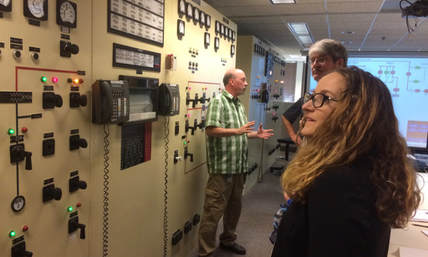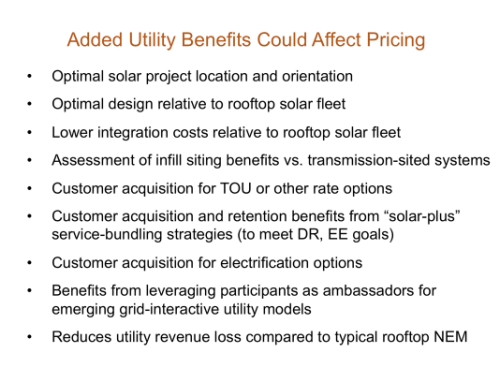
by Jill Cliburn
Are you planning a community solar program or looking for ways to make an existing program better? We think you will find every corner of this website useful; we've been assessing best practices and introducing innovations in this field for more than two and one-half years. But one of the lessons we have learned is that easy access to information counts. Community solar program designers and other stakeholders (inside and outside the utility) often find themselves facing a specific challenge—a burning question on a short fuse.
For that reason, we are thrilled announce the debut of a new set of easy-access web pages. We are referring to the Solutions pages, which you can find right at the top, on our Menu bar, above.
By now, a lot of readers are gone from this blog, off to explore the Solutions web pages. Yes! But if you are still reading, here’s a quick summary of what we offer and why.
What’s on the Solutions pages? Six sets of resources, each addressing a major challenge area for community solar program design process. These challenge areas come right out of our mission statement: First, we review the planning process itself, and the challenge of establishing a truly collaborative effort, which crosses utility-department boundaries. Second, we offer a brief introduction to high-value, strategic community solar design. Third, a discussion of procurement for products (including project development) and services. Some of those decisions come right away, as they define the community solar business model, and others come up as your utility team gets down to the details of program design and delivery.
Fourth, we take a look at target market research and market segmentation. At CSVP, we are happy to refer readers to other resources that build marketing intelligence and strategy; we zero in on target marketing and program customization as a fairly new and especially promising approach. We also echo the process-collaboration theme, as we suggest ways to get specific market research through internal collaboration.
Fifth, we provide resources in an area where the CSVP has broken new ground. That is, designing the program with solar plus storage or demand-response companion measures in mind. Even utilities that do not see solar-plus strategies on their doorstep should give this web page a look. CSVP offers a guide to using demand response (DR) measures to add integration value, and a separate guide to understanding storage choices on both sides of the meter. As utilities nationwide confront greater market-penetration of solar, the strategies we introduce can help, in terms of integration value, local-service risk management, and in terms of making a strong transition to succeeding in markets where lots of players offer lots of DER options to your customers.
Finally, an area of CSVP innovation, which again ties back to cross-departmental and customer-driven requirements of community solar. That is, assessing and increasing the net value of the offer, through a streamlined analytic approach we call GAP: Getting at Price. This approach identifies a strategic goal and then works back, to close the GAP between what the utility needs and what the customer wants in program pricing. In addition to an overview and exemplary generic models that show how GAP works, we offer a round-up of 12 current community-solar pricing models, for readers to review.
Our approach? There are a few unifying themes to all of the work that the CSVP has led.
Of course, it is all based on field experience. The individual firms represented on our team each have decades of experience working with utilities, and a few have been pioneers in the community solar field. In addition, we have relied on input from our Utility Forum, a loose network of six to ten utilities (public power, IOUs, and occasionally electric co-ops) to share their successes and frustrations. In most cases, they also reviewed our work products.
Another way CSVP define its approach is around the term practical. One interpretation: We are not shy about recommending the good works of others. That includes work from some of our colleagues who are also co-funded by the U.S. DOE SunShot Solar Market Pathways Program. We provide direct links to some of their works and also offer annotated, linked resource lists in most of our challenge areas. In those publications, you’ll find a fast path to resources that may be hard to find, but hit one or another nail right on the head.
CSVP’s focus has been on asking utilities to push beyond the ordinary—to use their cross-departmental expertise, technical insights and customer knowledge to create community solar programs that really are win-wins. CSVP is also known for promoting the concept of using community solar as a market-based laboratory. Where else will you find customers eager to work with you to try this new approach to distributed PV and indeed to distributed PV plus storage or DR, engaging the community in real solutions that are scaleable and replicable to address the needs of the 21st century grid?
We hope you will enjoy these resources. Please continue to engage with us, as we would love to see your comments or get back in touch with you. While each participating firm on our project offers its own, extensive expertise, this project is also keeping a core group of consultants on-board to expand our offerings, beginning with on-site trainings, facilitation, and specific expertise in each challenge area, to help you to initiate or improve your own high-value community solar program.
joined CSVP for our 2017 Workshop, where we took a break to learn how the growing penetration
of renewables affects the big picture on the Western regional grid.



